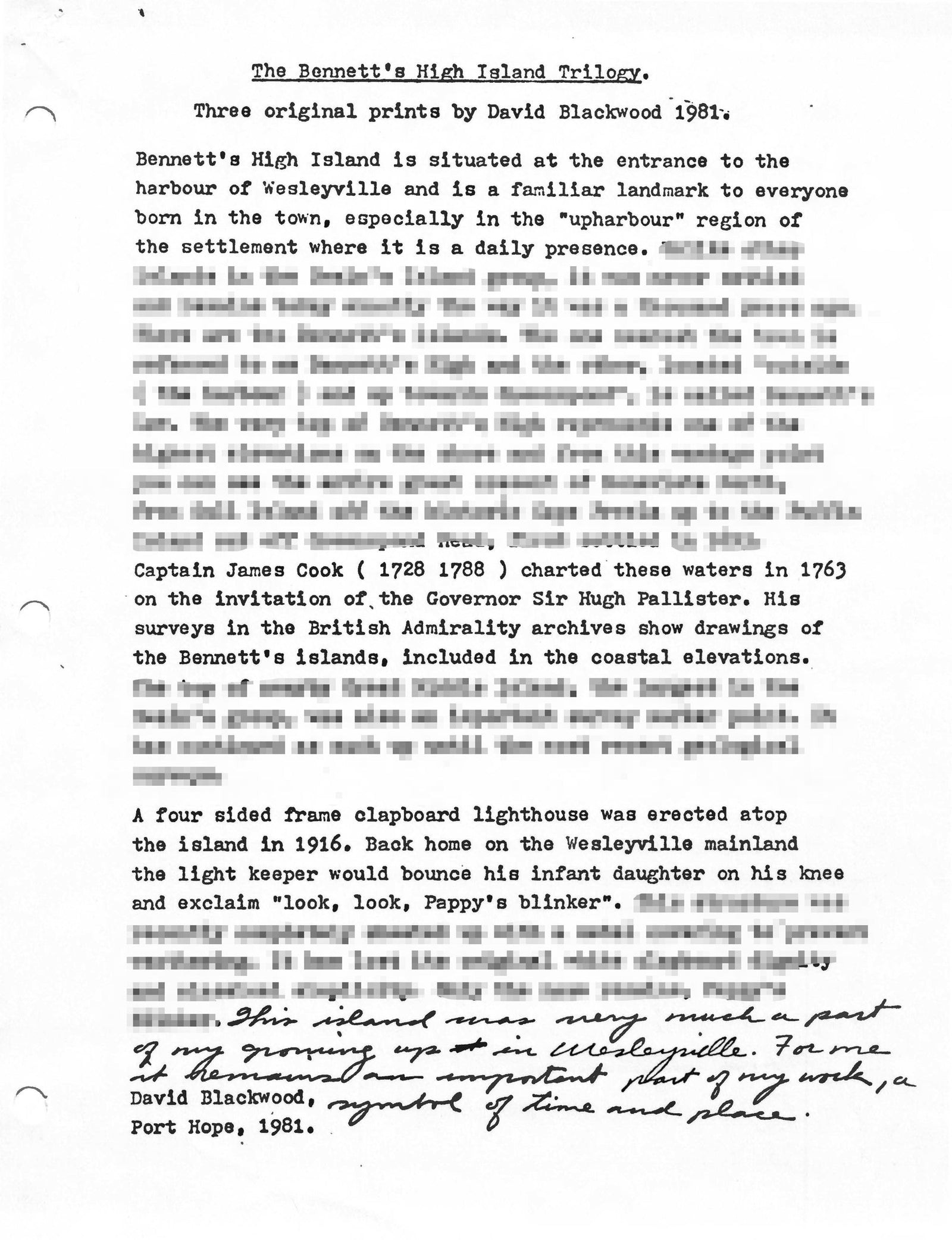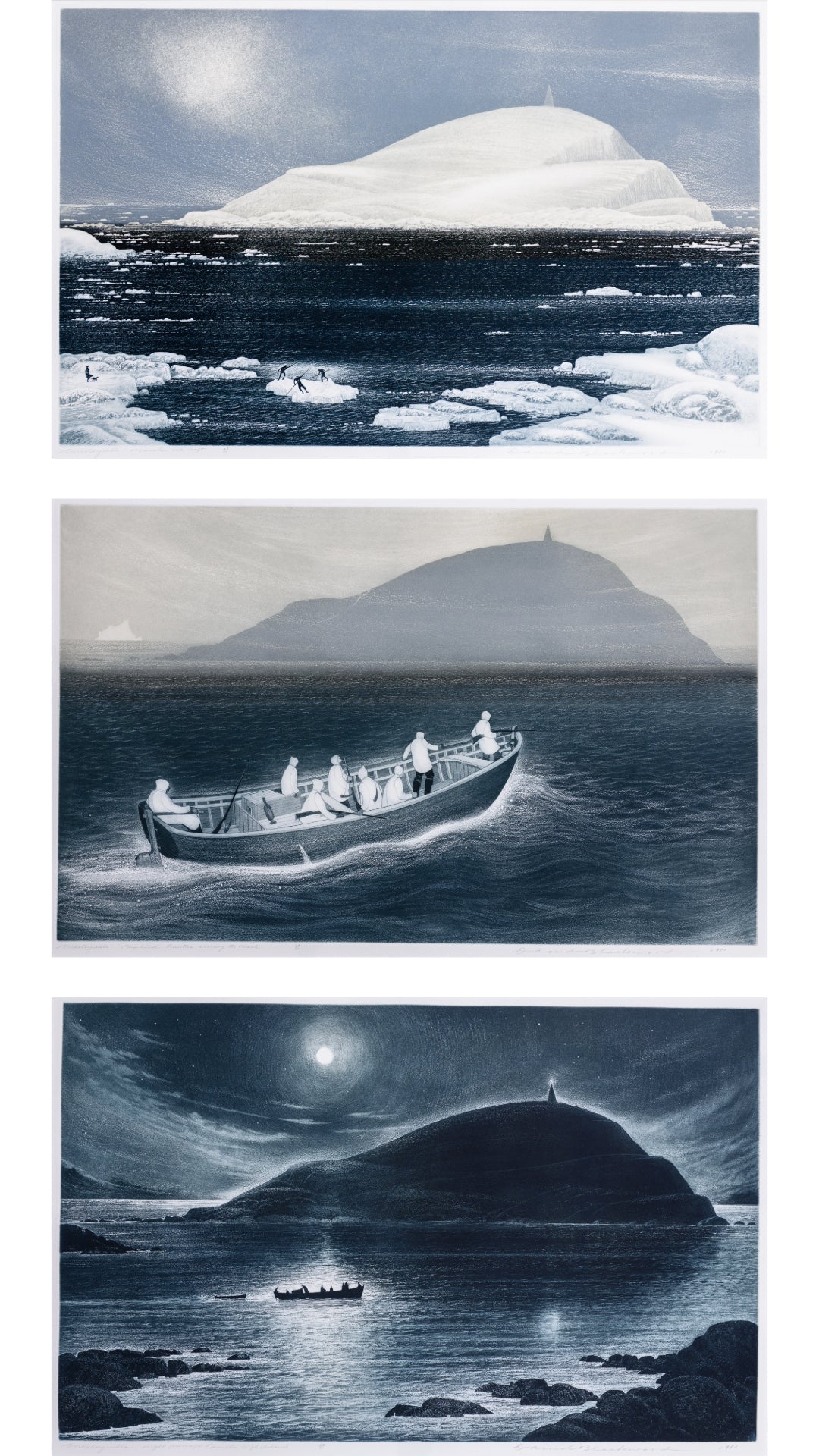Exploring the Legacy of David Blackwood’s Bennett’s High Island Trilogy
The trilogy captures the island's historical significance, dating back to 1763 when Captain James Cook charted these waters. The island is prominently featured in Cook's coastal surveys, highlighting its role as a critical navigational and survey point. The lighthouse, known as "Pappy's Blinker," was built in 1916 and signifies the island's importance to the local maritime community. Although now covered with metal sheeting to prevent weathering, the lighthouse's memory remains vivid in the hearts of Wesleyville's inhabitants.
For Blackwood, Bennett's High Island represents more than just a landscape; it symbolizes time and place, a testament to the resilience and continuity of Newfoundland's heritage. Through his trilogy, Blackwood offers a poignant reflection on the island's role in shaping his artistic vision and personal history, capturing the essence of a community's connection to its natural surroundings.

Adding to the significance of this trilogy are the original letters from David Blackwood, typed and personalized in 1987 and sent to the West End Gallery. These letters provide a comprehensive overview of the series and detailed descriptions of each print, offering profound insights into Blackwood's artistic process and personal connections to the works. The depth of information and the individual nature of these correspondences are unparalleled; no other gallery possesses such a unique collection of letters from the artist.
Only the new owner of this trilogy will receive copies of these letters, preserving the integrity and privacy of the originals while granting exclusive access to Blackwood's reflections and narratives. This exceptional combination of artwork and personal perspicuity from the artist elevates the trilogy's value and significance, making it an unparalleled acquisition for any art collector.
Letters to the West End Gallery from David Blackwood
These original letters are more than mere correspondence; they are a treasure trove of Blackwood’s reflections and experiences, capturing the essence of his inspirations and the stories behind his celebrated artworks. Each letter is a testament to Blackwood's meticulous attention to detail and his unwavering dedication to preserving the cultural and historical narratives of Newfoundland through his art.
Exclusive offer to the Purchaser
In an effort to honour the significance of these letters while maintaining their confidentiality, the West End Gallery has decided to provide a unique opportunity to the purchasers of the "Bennett's High Island Trilogy" prints. You will receive a copy of the non-redacted letters, offering an exclusive insight into Blackwood’s mind. Furthermore, the letters will continue to remain confidential, preserving the integrity and privacy of the original documents.
A Special Connection
For those who hold David Blackwood’s work dear, this is a rare opportunity to forge a deeper connection with the artist’s vision and legacy. The West End Gallery is honoured to facilitate this unique offering, ensuring that the spirit of David Blackwood's work continues to inspire and resonate for generations to come.
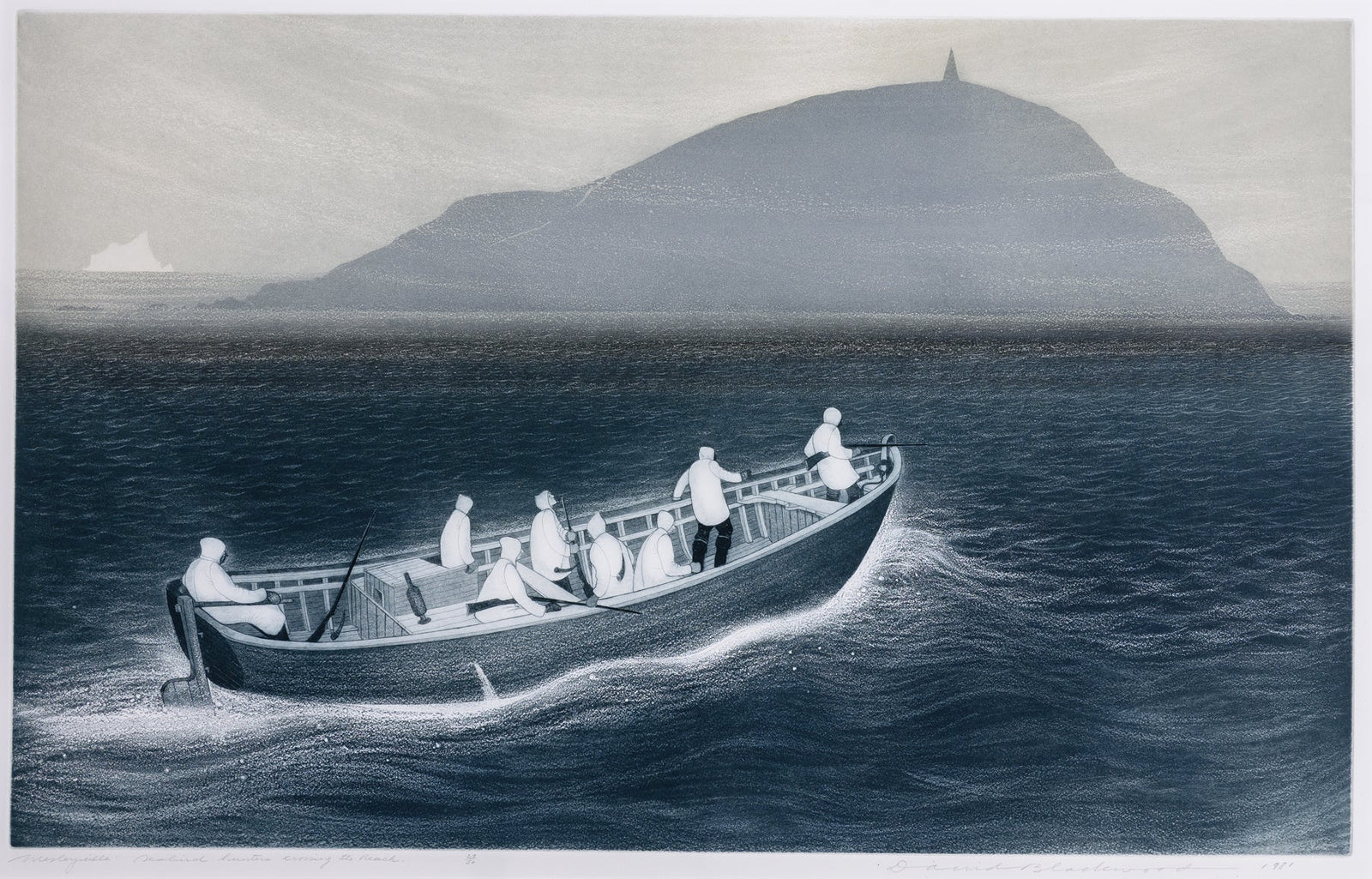
Wesleyville, Seabird Hunters Crossing the Reach
Visual Description:
The artwork depicts a group of seabird hunters crossing the Reach, a body of water between the mainland and Bennett's High Island, in a trapboat. The scene features eight hunters dressed in white cassocks, which blend with the surrounding ice, camouflaging them during their hunting expedition. Bennett's High Island looms in the background, adding a sense of place and scale to the scene.
Personal Connection:
This piece is a tribute to David Blackwood's father, Skipper Jim Hill, Heber Fifield, and other community members who engaged in seabird hunting. The white cassocks worn by the hunters were inspired by the Labrador codfishery and were made from flour sacking in Wesleyville. These garments helped the hunters blend into the icy landscape, making it easier to attract flocks of murres.
Cultural and Historical Significance:
Seabird hunting was a significant practice in Newfoundland, reflecting the resourcefulness and adaptability of its people. The use of white cassocks as camouflage shows the influence of the Labrador codfishery and the ingenuity of the hunters in utilizing available materials. This work captures a moment in the daily life of Wesleyville's inhabitants, showcasing their skills and traditions passed down through generations. It provides a window into the community's reliance on hunting and fishing for sustenance.
Personal Significance to the Artist:
David Blackwood's artwork is deeply rooted in his personal experiences and memories of Wesleyville. By depicting scenes such as seabird hunting, he preserves the cultural heritage and practices of his community. This piece, in particular, honours the memory of his father and other local hunters, highlighting their way of life and the techniques they employed.
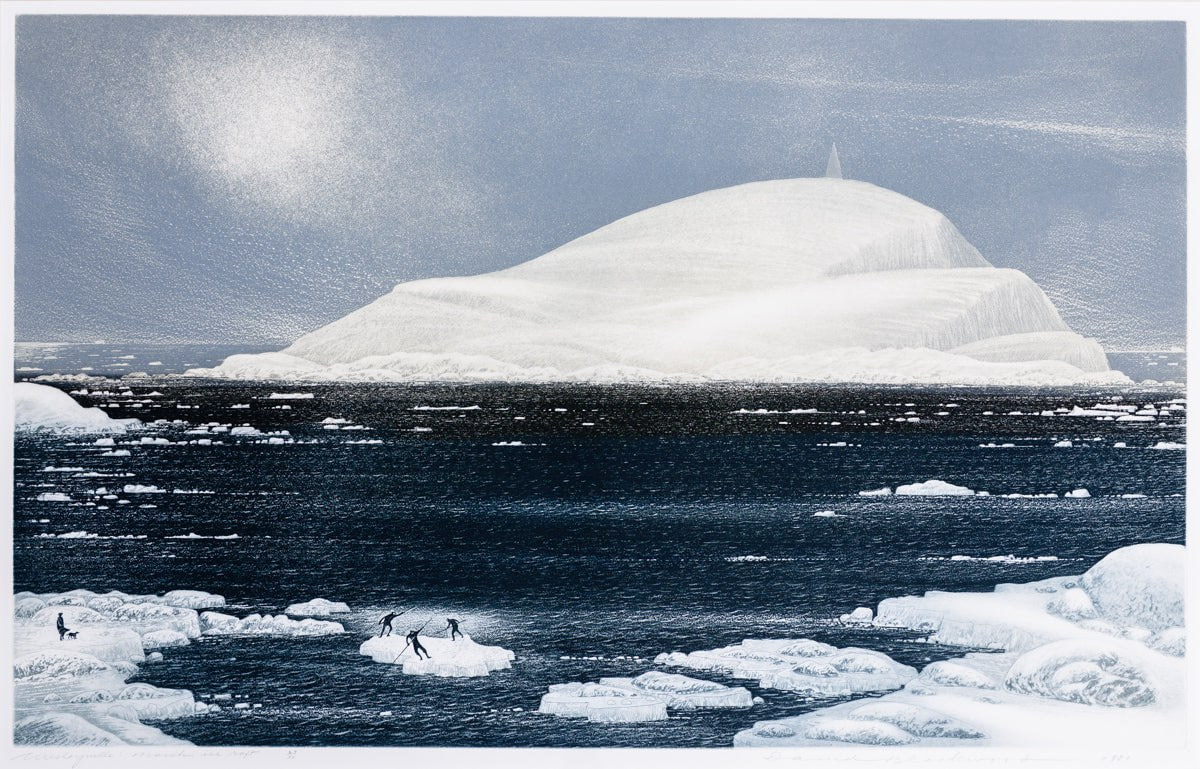
Wesleyville, featuring Bennett's High Island.
Visual Description:
The artwork captures a winter scene in Wesleyville, featuring Bennett's High Island covered in snow and surrounded by ice. The foreground shows children engaging in a local pastime called "tippypanning," where they jump from one small ice pan to another across a narrow body of water. This activity, also known as "copying" in other parts of Newfoundland, was a common and playful training ground for the more serious tasks encountered in the seal fishery.
Personal Connection:
David Blackwood's depiction of "tippypanning" reflects his childhood experiences in Wesleyville. During the months of March and April, the Reach would often be filled with drift ice, and the shoreline would be lined with thick ice shelves. After school, children would participate in this activity, which not only served as a playful pastime but also prepared them for the demanding tasks of the seal fishery. The larger ice rafts, crewed by two or three boys with long poles, were another popular after-school and weekend activity.
Cultural and Historical Significance:
The practice of "tippypanning" or "copying" was a traditional activity for children in Newfoundland, reflecting the community's adaptation to their harsh and icy environment. It also served as informal training for future roles in the seal fishery, a significant industry in The image of children navigating the ice pans is a poignant reminder of the daily life and traditions of coastal Newfoundland communities. This artwork preserves a unique aspect of local culture and heritage that is deeply tied to the region's history and environment.
Personal Significance to the Artist:
David Blackwood's personal history and connection to Wesleyville are evident in this piece. By capturing scenes from his childhood, he not only preserves his own memories but also shares the experiences of his community. This artwork highlights the resilience and adaptability of the people of Newfoundland, as well as the importance of local traditions and practices in shaping their way of life.
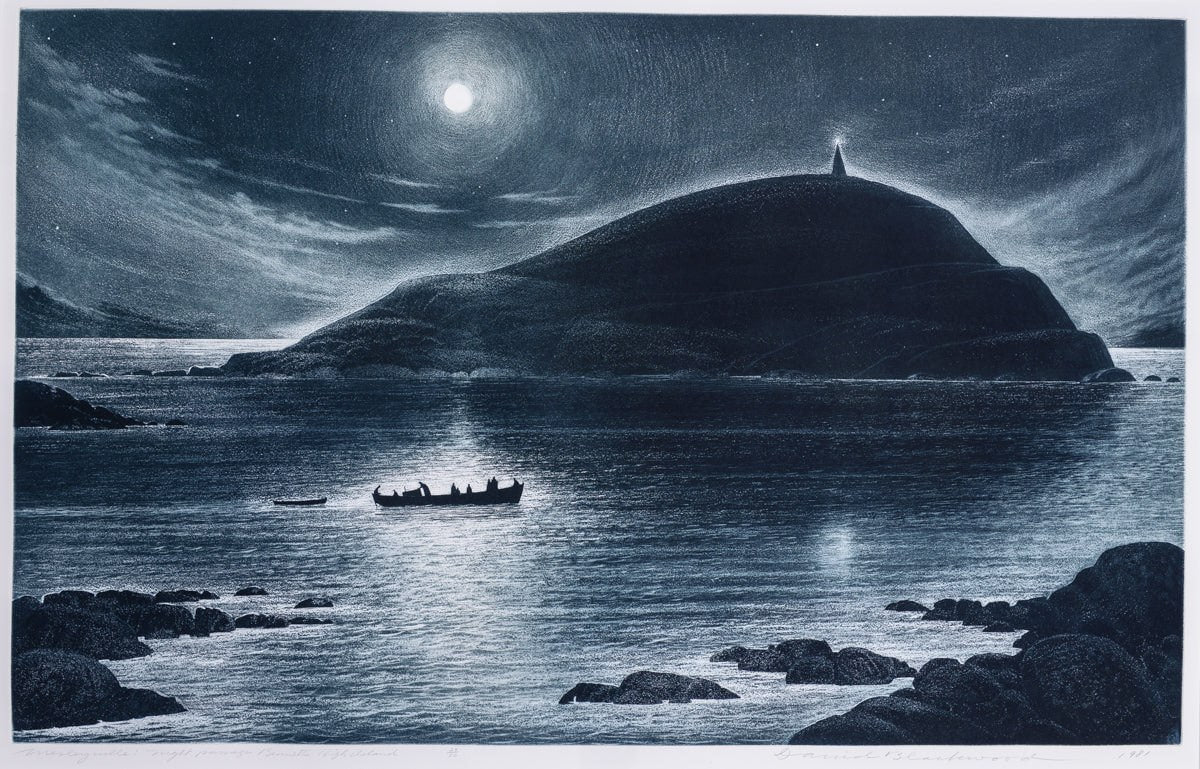
Wesleyville, Night Passage, Bennett's High Island.
Visual Description:
The artwork depicts Bennett's High Island as seen from Wesleyville under a moonlit night. A boat passes through the water, capturing the serene and timeless beauty of the scene. The lighthouse on the island, previously known as "Pappy's Blinker," stands prominently, guiding the boats through the calm waters.
Personal Connection:
David Blackwood created this piece based on the view from his childhood bedroom window, which was also the view from his studio window in Wesleyville. The building was constructed with this island in mind, located on the rocks above Wesleyville Harbour. During the 1940s, there were no motor cars in the town, and most minor traveling was done by boat. The expanse of water between the mainland and Bennett's Island, known as the Reach, was a common route for boats traveling to nearby communities like Greenspond, Brookfield, Newtown, and Cape Freels.
Cultural and Historical Significance:
Captain James Cook charted the waters around Bennett's High Island in 1763, making it a significant navigational point in the region. The lighthouse, erected in 1916 and known locally as "Pappy's Blinker." A four sided clapboard building, this lighthouse earned its nickname from the light keeper who would bounce his infant daughter on his knee and exclaim, "Look, look, Pappy's blinker," as they watched the light from their home. It was later covered with metal sheeting to prevent weathering, altering its original aesthetic - only the local residence recall the story.
Personal Significance to the Artist:
David Blackwood's personal history is deeply intertwined with Bennett's High Island. The island's presence in his life, from childhood to his professional career, influenced his artistic vision and thematic choices. This piece captures the tranquil beauty and historical depth of the region, reflecting Blackwood's connection to his Newfoundland roots.
This is your opportunity to own all three etchings, signed and numbered 29 of 50. Don't let history slip through your fingers!
View the complete trilogy and enquire today!
Disclaimer and Acknowledgment
We have made every effort to ensure the accuracy of the information presented in this overview of David Blackwood's Bennett's High Island Trilogy. The details provided are supported by a variety of sources, including internal documented records, interviews, and articles from the Edmonton Journal supplied by Newspapers.com. However, we acknowledge that despite our best efforts, there may be some errors or omissions.
The core of this writing was researched and written by Matthew Hudon, with the assistance of Grammarly for spelling, grammatical accuracy, and transcription of newspaper articles from the Edmonton Journal. We encourage readers to consider the context and sources when interpreting the information presented.

